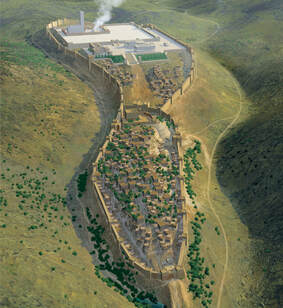
How could it possibly be where this artist's impression shows it?
The writer of Psalm 119, in verse 16 says,
‘I will pay my vows to the Lord
Now in the presence of all His people,
In the courts of the LORD’S house,
In the midst of you, O Jerusalem’
TAVEK is the Hebrew word and it means middle, centre, midst.
It is used again by Ezekiel, who sees ministers of judgement dispatched to clean up Jerusalem. They are to go through the midst of the city and begin at the sanctuary (Ezk. 9:4 etc)
Later in Chapter 11, Ezekiel sees the Glory of God departing the temple (where the Glory dwelt) and he sees it depart (verse 11) from the midst of the city.
In Zechariah 2:5 God promises to be the wall of fire around the city and the Glory in its midst.
Zechariah later described the return of the Glory in Chapter 8 verse 3 of his book; ‘I will return to Zion and dwell in the midst of Jerusalem.’
In all the above, the word is TAVEK.
In Jeremiah’s Lamentations he laments over the destruction of the sanctuary and says,
‘How the gold has become dim!
How changed the fine gold!
The stones of the sanctuary are scattered
At the head of every street’
He is speaking, not of the precious stones for they would be taken as spoil, but of the building stones. If they were scattered at the head of every street, clearly the streest of the city ran to and about the temple precinct.
In Psalm 46:5, the sons of Korah are singing the praises of the God as their refuge and strength. Verse 4 speaks of the river that makes glad the city of God and the dwelling place of the Most High (the Gihon stream)—and then in verse 5, ‘God is in her midst, she shall not be moved.’
In this case the Hebrew word is QEREB meaning the inward or innermost part (in Exodus 29:13 it is used of the entrails of the animal).
 RSS Feed
RSS Feed
